I work on a lot of older PC’s. Whether its the overall price tag of an upgrade or the fear of having to deal with something new, people tend to prefer the status quo. And for many that remains Windows XP. The “don’t fix it if it ain’t broke approach” has some advantages…a familiar environment, for example, allows people to be more productive. Time behind the wheel, as they say, is the reason some prefer to delay an upgrade. When it comes down to changing habits formed by years of repetitive use productivity can be hampered. So, if you’re one of those people that prefer the eleven year old unsupported predecessor to 7…and are wondering how to speed it up, here is how:
First off, let me delve into some of the reasons Windows XP tends to get sluggish with time. As you use your computer over time, you create and acquire data. Lots of it. Unfortunately Windows XP has some design flaws that cause it to get bogged down by all that data you are creating. As your My Documents and Program Files folders grow over time, Windows XP has more and more things to keep track of…more things to keep in mind so to speak…and this causes it to inevitably slow down. The problem is not entirely with the operating system alone though. As with any complicated system, there are multiple layers that contribute to the problem and to get to a solution a multi-tiered approach is required. Here is my check-list of things that will speed up Windows XP and the reasons they work.
[step 1] Turn off Indexing.
[step a] Right click the C: drive and select Properties. Un-check the box that says “Allow indexing service to index this disk for fast file searching”.
[step b] In the Confirm Attribute Changes dialog, select All changes to C:, subfolders and files. Click OK.
[step 3] Ignore All Errors.
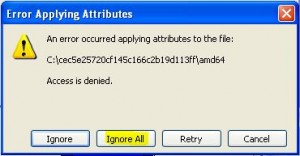
[step c] Set the Indexing Service to Manual (and stop it if it is running). To get to services, click Start->Control Panel->Administrative Tools->Services and find the Indexing Service.
[step d] (optional) Clear your index catalog. Right-click My Computer and select Manage. Then click Indexing Service and right click the default index and select All Tasks->Empty Catalog.
Most people don’t realize that hard drive indexing creates a huge searchable database of all the stuff inside your files. In my experience 95% of desktop searches involve searching for terms in file/folder names. If you’re not searching for stuff inside a file, you don’t need indexing. I’ve seen XP machines with a 20GB index. Products like Windows Search and Google Desktop Search attempt to improve XP’s native indexing and search capabilities but they tend to make the problem worse. If you want a faster computer, turn indexing off. If you need to search the contents of files, install a copy of PowerGREP or Windows Grep.
[step 2] Upgrade your hard drive.

As your disk fills up with data blocks, reaching the bits you want takes more seek time. If your hard drive is more than 60% utilized, you’ll notice a significant speed improvement if you upgrade to a disk that will be less than 30% utilized. Additionally, modern hard drives typically have larger amounts of cache allowing your drive to spend less time seeking platters to retrieve the data you want now. I recommend SATA3 drives with at least 16MB of cache or more…steer clear of the bargain “green” drives. They are slow performers. Go Western Digital Black for best performance. Most new hard drives come with software that will allow you to clone your existing disk to the new one in 30 minutes or less.
- EaseUs Disk Copy
- Seagate Disk Wizard
- Acronis True Image WD Edition
- YouTube Video on how to use Acronis True Image
[step 3] Upgrade your RAM.
If your PC has less than 2GB of RAM memory, it’s time to get some more. Don’t go crazy though, XP is mostly a 32bit operating system. That means it can only address about (2^32) bytes = ~4 gigabytes of RAM. If you go out and buy 8GB, the most you’ll ever use is ~4GB.
[step 4] Get CCleaner.
Installing Applications and browsing the web creates temporary files. Lots of ’em. For a while they help you do things faster, but XP has no mechanism for deleting stale temp files, so they just pile up. When enough of these files exist, XP performance will be impacted. CCleaner is a free utility that can pear down the amount of temporary files on your system using the Cleaner tab. Here are the relatively safe options I tend to select for clearing temp data using CCleaner:
| Internet Explorer |
|
| Temporary Internet Files | Removes temp files |
| Index.dat files | Clears the internet cache database |
| Windows Explorer | |
| Thumbnail Cache | Clears the thumbnail cache |
| System | |
| Empty Recycle Bin | Empties your trash |
| Temporary Files | Deletes Windows temp files |
| Memory Dumps | Deletes memory Dumps |
| Clipboard | Removes items from clipboard |
| Chkdsk File Fragments | Removes chkdsk fragments |
| Windows Log Files | Removes unnecessary logs |
| Windows Error Reporting | Removes error reports |
| DNS Cache | Flushes your DNS cache |
| Font Cache | Clears the font cache |
| Advanced | |
| Old Prefetch data | Removes old prefetch data |
| IIS Log files | (if you are running IIS) |
| Hotfix Uninstallers | (if your system is patched and stable) |
| Applications | |
| Firefox | Same as Internet Explorer |
| Chrome | Same as Internet Explorer |
| Adobe Acrobat Reader | |
| Office 2003/2007/2010 | |
| Internet | |
| Sun Java |
CCleaner can also help you pear down your start-up items. These are generally programs that run when your computer starts and end up in the notification area or background. They can slow your computer down, so here are the ones I typically disable because they’re not needed:
| Startup program | Enabled? |
| Google Update | No |
| ISUSPM | No |
| Acrobat Assistant | No |
| Adobe Acrobat Speed Launcher | No |
| Adobe ARM | No |
| AppleSyncNotifier | No |
| ArcSoft Connection Service | No |
| GrooveMonitor | No |
| HotKeyCmds | No |
| HP Software Update | No |
| LWS (or anything Logitech Webcam related) | No |
| PowerDVD (or anything related) | No |
| QuickTime Task | No |
| Roxio (or anything related) | No |
| swg | No |
| SunJavaUpdateSched | No |
[step 5] Stop/disable some services
Click Start->run… and enter services.msc, then click OK to bring up the Services Dialog.
Windows Services are service applications that run behind the scenes and allow your computer do to everything from browsing the internet to sharing files and folders. There are Windows services (those services are part of the XP operating system) and third party application services installed by some applications. Many of these third party application services are not critical for your computer to function and some will hamper performance. The Services management dialog allows you to start, stop, enable and disable various services. Here is a list of services that are part of a “fresh” Windows XP SP3 install. Do not modify these services:
| Name | Description | Status | Startup Type | Log On As |
| .NET Runtime Optimization Service v2.0.50727_X86 | Microsoft .NET Framework NGEN | Manual | Local System | |
| Adobe Flash Player Update Service | This service keeps your Adobe Flash Player installation up to date with the latest enhancements and security fixes. | Manual | Local System | |
| Alerter | Notifies selected users and computers of administrative alerts. If the service is stopped, programs that use administrative alerts will not receive them. If this service is disabled, any services that explicitly depend on it will fail to start. | Disabled | Local Service | |
| Application Layer Gateway Service | Provides support for 3rd party protocol plug-ins for Internet Connection Sharing and the Windows Firewall. | Started | Manual | Local Service |
| Application Management | Provides software installation services such as Assign, Publish, and Remove. | Manual | Local System | |
| ASP.NET State Service | Provides support for out-of-process session states for ASP.NET. If this service is stopped, out-of-process requests will not be processed. If this service is disabled, any services that explicitly depend on it will fail to start. | Manual | Network Service | |
| Automatic Updates | Enables the download and installation of Windows updates. If this service is disabled, this computer will not be able to use the Automatic Updates feature or the Windows Update Web site. | Started | Automatic | Local System |
| Background Intelligent Transfer Service | Transfers files in the background using idle network bandwidth. If the service is stopped, features such as Windows Update, and MSN Explorer will be unable to automatically download programs and other information. If this service is disabled, any services that explicitly depend on it may fail to transfer files if they do not have a fail safe mechanism to transfer files directly through IE in case BITS has been disabled. | Started | Manual | Local System |
| ClipBook | Enables ClipBook Viewer to store information and share it with remote computers. If the service is stopped, ClipBook Viewer will not be able to share information with remote computers. If this service is disabled, any services that explicitly depend on it will fail to start. | Disabled | Local System | |
| COM+ Event System | Supports System Event Notification Service (SENS), which provides automatic distribution of events to subscribing Component Object Model (COM) components. If the service is stopped, SENS will close and will not be able to provide logon and logoff notifications. If this service is disabled, any services that explicitly depend on it will fail to start. | Started | Manual | Local System |
| COM+ System Application | Manages the configuration and tracking of Component Object Model (COM)+-based components. If the service is stopped, most COM+-based components will not function properly. If this service is disabled, any services that explicitly depend on it will fail to start. | Manual | Local System | |
| Computer Browser | Maintains an updated list of computers on the network and supplies this list to computers designated as browsers. If this service is stopped, this list will not be updated or maintained. If this service is disabled, any services that explicitly depend on it will fail to start. | Automatic | Local System | |
| Cryptographic Services | Provides three management services: Catalog Database Service, which confirms the signatures of Windows files; Protected Root Service, which adds and removes Trusted Root Certification Authority certificates from this computer; and Key Service, which helps enroll this computer for certificates. If this service is stopped, these management services will not function properly. If this service is disabled, any services that explicitly depend on it will fail to start. | Started | Automatic | Local System |
| DCOM Server Process Launcher | Provides launch functionality for DCOM services. | Started | Automatic | Local System |
| DHCP Client | Manages network configuration by registering and updating IP addresses and DNS names. | Started | Automatic | Local System |
| Distributed Link Tracking Client | Maintains links between NTFS files within a computer or across computers in a network domain. | Started | Automatic | Local System |
| Distributed Transaction Coordinator | Coordinates transactions that span multiple resource managers, such as databases, message queues, and file systems. If this service is stopped, these transactions will not occur. If this service is disabled, any services that explicitly depend on it will fail to start. | Manual | Network Service | |
| DNS Client | Resolves and caches Domain Name System (DNS) names for this computer. If this service is stopped, this computer will not be able to resolve DNS names and locate Active Directory domain controllers. If this service is disabled, any services that explicitly depend on it will fail to start. | Started | Automatic | Network Service |
| Error Reporting Service | Allows error reporting for services and applications running in non-standard environments. | Started | Automatic | Local System |
| Event Log | Enables event log messages issued by Windows-based programs and components to be viewed in Event Viewer. This service cannot be stopped. | Started | Automatic | Local System |
| Extensible Authentication Protocol Service | Provides windows clients Extensible Authentication Protocol Service | Manual | Local System | |
| Fast User Switching Compatibility | Provides management for applications that require assistance in a multiple user environment. | Manual | Local System | |
| Health Key and Certificate Management Service | Manages health certificates and keys (used by NAP) | Manual | Local System | |
| Help and Support | Enables Help and Support Center to run on this computer. If this service is stopped, Help and Support Center will be unavailable. If this service is disabled, any services that explicitly depend on it will fail to start. | Started | Automatic | Local System |
| HTTP SSL | This service implements the secure hypertext transfer protocol (HTTPS) for the HTTP service, using the Secure Socket Layer (SSL). If this service is disabled, any services that explicitly depend on it will fail to start. | Manual | Local System | |
| Human Interface Device Access | Enables generic input access to Human Interface Devices (HID), which activates and maintains the use of predefined hot buttons on keyboards, remote controls, and other multimedia devices. If this service is stopped, hot buttons controlled by this service will no longer function. If this service is disabled, any services that explicitly depend on it will fail to start. | Disabled | Local System | |
| IMAPI CD-Burning COM Service | Manages CD recording using Image Mastering Applications Programming Interface (IMAPI). If this service is stopped, this computer will be unable to record CDs. If this service is disabled, any services that explicitly depend on it will fail to start. | Manual | Local System | |
| Indexing Service | Indexes contents and properties of files on local and remote computers; provides rapid access to files through flexible querying language. | Manual | Local System | |
| IPSEC Services | Manages IP security policy and starts the ISAKMP/Oakley (IKE) and the IP security driver. | Started | Automatic | Local System |
| Logical Disk Manager | Detects and monitors new hard disk drives and sends disk volume information to Logical Disk Manager Administrative Service for configuration. If this service is stopped, dynamic disk status and configuration information may become out of date. If this service is disabled, any services that explicitly depend on it will fail to start. | Started | Automatic | Local System |
| Logical Disk Manager Administrative Service | Configures hard disk drives and volumes. The service only runs for configuration processes and then stops. | Manual | Local System | |
| Messenger | Transmits net send and Alerter service messages between clients and servers. This service is not related to Windows Messenger. If this service is stopped, Alerter messages will not be transmitted. If this service is disabled, any services that explicitly depend on it will fail to start. | Disabled | Local System | |
| Microsoft Office Diagnostics Service | Run portions of Microsoft Office Diagnostics. | Manual | Local System | |
| MS Software Shadow Copy Provider | Manages software-based volume shadow copies taken by the Volume Shadow Copy service. If this service is stopped, software-based volume shadow copies cannot be managed. If this service is disabled, any services that explicitly depend on it will fail to start. | Manual | Local System | |
| Net Logon | Supports pass-through authentication of account logon events for computers in a domain. | Started | Automatic | Local System |
| Net.Tcp Port Sharing Service | Provides ability to share TCP ports over the net.tcp protocol. | Disabled | Local Service | |
| NetMeeting Remote Desktop Sharing | Enables an authorized user to access this computer remotely by using NetMeeting over a corporate intranet. If this service is stopped, remote desktop sharing will be unavailable. If this service is disabled, any services that explicitly depend on it will fail to start. | Manual | Local System | |
| Network Access Protection Agent | Allows windows clients to participate in Network Access Protection | Manual | Local System | |
| Network Connections | Manages objects in the Network and Dial-Up Connections folder, in which you can view both local area network and remote connections. | Started | Manual | Local System |
| Network DDE | Provides network transport and security for Dynamic Data Exchange (DDE) for programs running on the same computer or on different computers. If this service is stopped, DDE transport and security will be unavailable. If this service is disabled, any services that explicitly depend on it will fail to start. | Disabled | Local System | |
| Network DDE DSDM | Manages Dynamic Data Exchange (DDE) network shares. If this service is stopped, DDE network shares will be unavailable. If this service is disabled, any services that explicitly depend on it will fail to start. | Disabled | Local System | |
| Network Location Awareness (NLA) | Collects and stores network configuration and location information, and notifies applications when this information changes. | Started | Manual | Local System |
| Network Provisioning Service | Manages XML configuration files on a domain basis for automatic network provisioning. | Manual | Local System | |
| NT LM Security Support Provider | Provides security to remote procedure call (RPC) programs that use transports other than named pipes. | Manual | Local System | |
| Office Source Engine | Saves installation files used for updates and repairs and is required for the downloading of Setup updates and Watson error reports. | Manual | Local System | |
| Performance Logs and Alerts | Collects performance data from local or remote computers based on preconfigured schedule parameters, then writes the data to a log or triggers an alert. If this service is stopped, performance information will not be collected. If this service is disabled, any services that explicitly depend on it will fail to start. | Manual | Network Service | |
| Plug and Play | Enables a computer to recognize and adapt to hardware changes with little or no user input. Stopping or disabling this service will result in system instability. | Started | Automatic | Local System |
| Portable Media Serial Number Service | Retrieves the serial number of any portable media player connected to this computer. If this service is stopped, protected content might not be down loaded to the device. | Manual | Local System | |
| Print Spooler | Loads files to memory for later printing. | Started | Automatic | Local System |
| Protected Storage | Provides protected storage for sensitive data, such as private keys, to prevent access by unauthorized services, processes, or users. | Started | Automatic | Local System |
| QoS RSVP | Provides network signaling and local traffic control setup functionality for QoS-aware programs and control applets. | Manual | Local System | |
| Remote Access Auto Connection Manager | Creates a connection to a remote network whenever a program references a remote DNS or NetBIOS name or address. | Manual | Local System | |
| Remote Access Connection Manager | Creates a network connection. | Started | Manual | Local System |
| Remote Desktop Help Session Manager | Manages and controls Remote Assistance. If this service is stopped, Remote Assistance will be unavailable. Before stopping this service, see the Dependencies tab of the Properties dialog box. | Manual | Local System | |
| Remote Procedure Call (RPC) | Provides the endpoint mapper and other miscellaneous RPC services. | Started | Automatic | Network Service |
| Remote Procedure Call (RPC) Locator | Manages the RPC name service database. | Manual | Network Service | |
| Remote Registry | Enables remote users to modify registry settings on this computer. If this service is stopped, the registry can be modified only by users on this computer. If this service is disabled, any services that explicitly depend on it will fail to start. | Started | Automatic | Local Service |
| Removable Storage | Manual | Local System | ||
| Routing and Remote Access | Offers routing services to businesses in local area and wide area network environments. | Disabled | Local System | |
| Secondary Logon | Enables starting processes under alternate credentials. If this service is stopped, this type of logon access will be unavailable. If this service is disabled, any services that explicitly depend on it will fail to start. | Started | Automatic | Local System |
| Security Accounts Manager | Stores security information for local user accounts. | Started | Automatic | Local System |
| Security Center | Monitors system security settings and configurations. | Automatic | Local System | |
| Server | Supports file, print, and named-pipe sharing over the network for this computer. If this service is stopped, these functions will be unavailable. If this service is disabled, any services that explicitly depend on it will fail to start. | Started | Automatic | Local System |
| Shell Hardware Detection | Provides notifications for AutoPlay hardware events. | Started | Automatic | Local System |
| Smart Card | Manages access to smart cards read by this computer. If this service is stopped, this computer will be unable to read smart cards. If this service is disabled, any services that explicitly depend on it will fail to start. | Manual | Local Service | |
| SSDP Discovery Service | Enables discovery of UPnP devices on your home network. | Started | Manual | Local Service |
| System Event Notification | Tracks system events such as Windows logon, network, and power events. Notifies COM+ Event System subscribers of these events. | Started | Automatic | Local System |
| System Restore Service | Performs system restore functions. To stop service, turn off System Restore from the System Restore tab in My Computer->Properties | Started | Automatic | Local System |
| Task Scheduler | Enables a user to configure and schedule automated tasks on this computer. If this service is stopped, these tasks will not be run at their scheduled times. If this service is disabled, any services that explicitly depend on it will fail to start. | Started | Automatic | Local System |
| TCP/IP NetBIOS Helper | Enables support for NetBIOS over TCP/IP (NetBT) service and NetBIOS name resolution. | Started | Automatic | Local Service |
| Telephony | Provides Telephony API (TAPI) support for programs that control telephony devices and IP based voice connections on the local computer and, through the LAN, on servers that are also running the service. | Started | Manual | Local System |
| Telnet | Enables a remote user to log on to this computer and run programs, and supports various TCP/IP Telnet clients, including UNIX-based and Windows-based computers. If this service is stopped, remote user access to programs might be unavailable. If this service is disabled, any services that explicitly depend on it will fail to start. | Disabled | Local System | |
| Terminal Services | Allows multiple users to be connected interactively to a machine as well as the display of desktops and applications to remote computers. The underpinning of Remote Desktop (including RD for Administrators), Fast User Switching, Remote Assistance, and Terminal Server. | Started | Manual | Local System |
| Themes | Provides user experience theme management. | Started | Automatic | Local System |
| Uninterruptible Power Supply | Manages an uninterruptible power supply (UPS) connected to the computer. | Manual | Local Service | |
| Universal Plug and Play Device Host | Provides support to host Universal Plug and Play devices. | Manual | Local Service | |
| VirtualBox Guest Additions Service | Manages VM runtime information, time synchronization, remote sysprep execution and miscellaneous utilities for guest operating systems. | Started | Automatic | Local System |
| Volume Shadow Copy | Manages and implements Volume Shadow Copies used for backup and other purposes. If this service is stopped, shadow copies will be unavailable for backup and the backup may fail. If this service is disabled, any services that explicitly depend on it will fail to start. | Manual | Local System | |
| WebClient | Enables Windows-based programs to create, access, and modify Internet-based files. If this service is stopped, these functions will not be available. If this service is disabled, any services that explicitly depend on it will fail to start. | Started | Automatic | Local Service |
| Windows Audio | Manages audio devices for Windows-based programs. If this service is stopped, audio devices and effects will not function properly. If this service is disabled, any services that explicitly depend on it will fail to start. | Started | Automatic | Local System |
| Windows CardSpace | Securely enables the creation, management, and disclosure of digital identities. | Manual | Local System | |
| Windows Firewall/Internet Connection Sharing (ICS) | Provides network address translation, addressing, name resolution and/or intrusion prevention services for a home or small office network. | Started | Automatic | Local System |
| Windows Image Acquisition (WIA) | Provides image acquisition services for scanners and cameras. | Manual | Local System | |
| Windows Installer | Adds, modifies, and removes applications provided as a Windows Installer (*.msi) package. If this service is disabled, any services that explicitly depend on it will fail to start. | Manual | Local System | |
| Windows Management Instrumentation | Provides a common interface and object model to access management information about operating system, devices, applications and services. If this service is stopped, most Windows-based software will not function properly. If this service is disabled, any services that explicitly depend on it will fail to start. | Started | Automatic | Local System |
| Windows Management Instrumentation Driver Extensions | Provides systems management information to and from drivers. | Manual | Local System | |
| Windows Presentation Foundation Font Cache 3.0.0.0 | Optimizes performance of Windows Presentation Foundation (WPF) applications by caching commonly used font data. WPF applications will start this service if it is not already running. It can be disabled, though doing so will degrade the performance of WPF applications. | Manual | Local Service | |
| Windows Time | Maintains date and time synchronization on all clients and servers in the network. If this service is stopped, date and time synchronization will be unavailable. If this service is disabled, any services that explicitly depend on it will fail to start. | |||
| Started | Automatic | Local System | ||
| Wired AutoConfig | This service performs IEEE 802.1X authentication on Ethernet interfaces | Manual | Local System | |
| Wireless Zero Configuration | Provides automatic configuration for the 802.11 adapters | Started | Automatic | Local System |
| WMI Performance Adapter | Provides performance library information from WMI HiPerf providers. | Manual | Local System | |
| Workstation | Creates and maintains client network connections to remote servers. If this service is stopped, these connections will be unavailable. If this service is disabled, any services that explicitly depend on it will fail to start. | Started | Automatic | Local System |
NOTE: As a good rule of thumb, I usually set services not part of the list above to Manual before completely disabling anything. This way the service is not completely blocked from working, just blocked from starting automatically with your computer. Apple device and helper services are a good example services that fall in this category.
[step 6] Uninstall programs.
If you don’t need it, uninstall it! Microsoft has chosen not to force developers to use a single standardized installer, so some applications uninstall cleanly and some leave lots items behind. IObit uninstaller is a great free tool to cleanup files left behind by poorly developed uninstallers.
[step 7] Defrag.
Click Start->All Programs->Accessories->System Tools->Disk Defragmenter.
As you create data on your computer, it stores files in random unoccupied spots on the hard disk. Over time as your disk becomes more and more utilized, the random placement of all these files (also known as fragmentation) will become an issue that can affect XP performance. Defragmenting the hard drive means organizing data randomly stored on your hard drive into contiguous blocks and optimizing free space. This should be done quarterly.
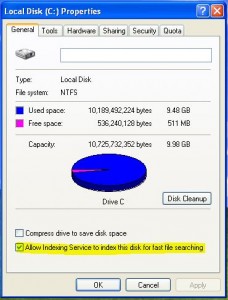
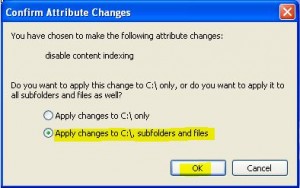
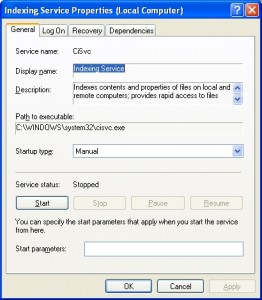
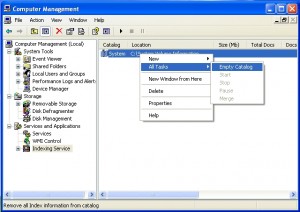


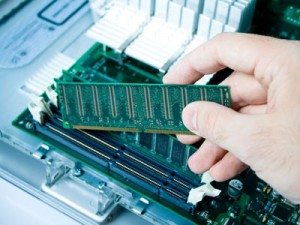
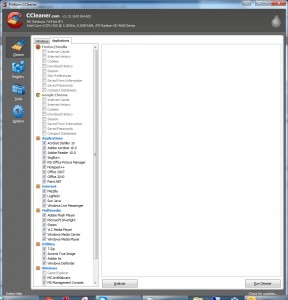
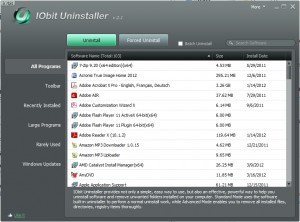

Comments
3 responses to “Why is my windows xp computer running slow?”
Thanks Dave, Gonna get PowerGrep – Good to get an insight into the various things that slow my old xp up.
i used your windows services guide and it helped alot. seems leaving settings manual, works better than disabled. i’ve done other settings, but this was closer to what i needed. after 10 years i still consider myself to be a newbee. I like xp some, the newer stuff seems bass ackwards.
//Ed
I used the windows services guide. I am using Network Magic and an error message “Platform services not running” appears every day. Why, I don’t know. But now I know how to correct it. Thank you so much. I’ve subscribed to your blog too. Wish I had found your website long ago.
John